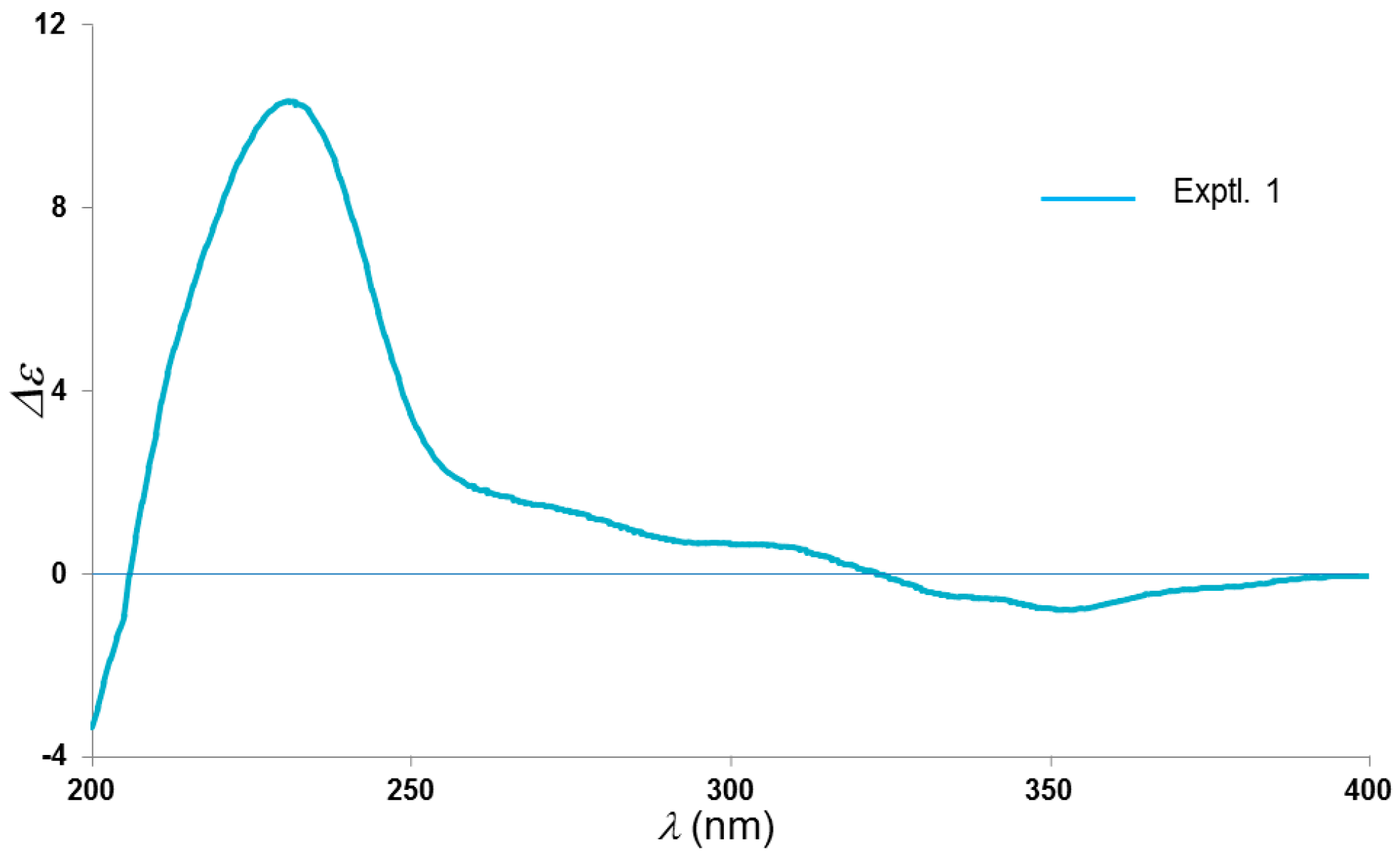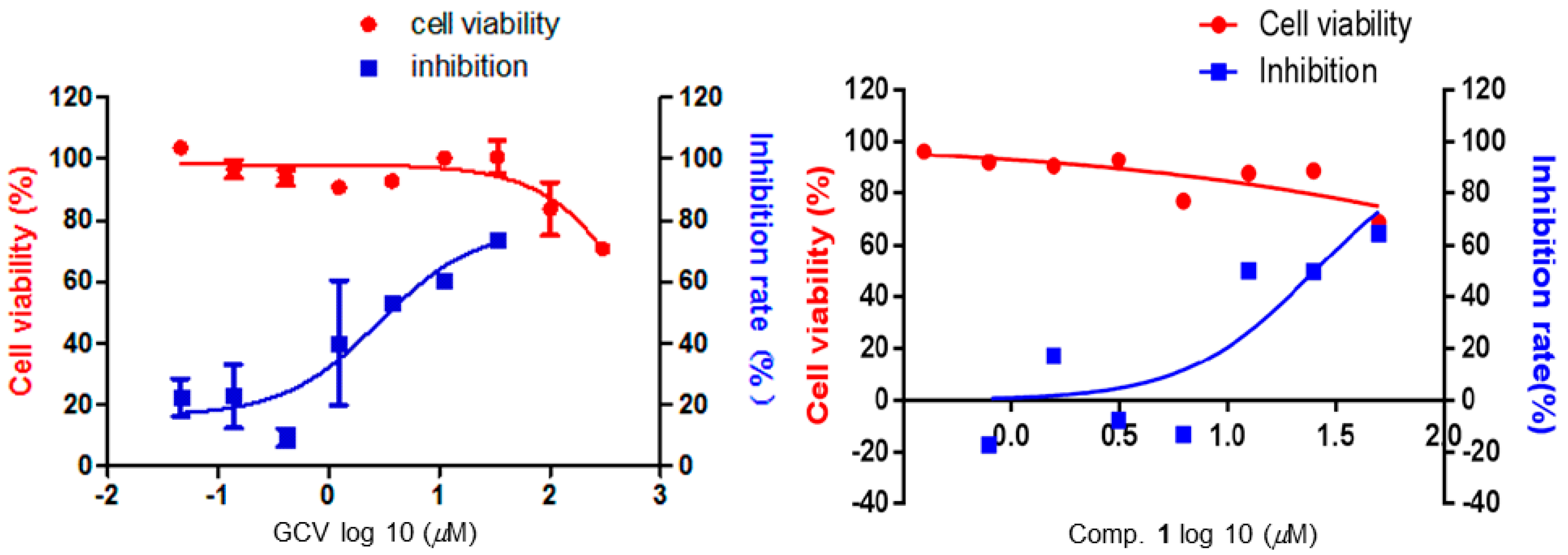Hyperjaponol H, A New Bioactive Filicinic Acid-Based Meroterpenoid from Hypericum japonicum Thunb. ex Murray
Abstract
:1. Introduction
2. Results and Discussion
3. Materials and Methods
3.1. General Experiments
3.2. Plant Material
3.3. Extraction and Isolation
3.4. Anti-EBV Assay
4. Conclusions
Supplementary Materials
Acknowledgments
Author Contributions
Conflicts of Interest
References
- Singh, I.P.; Sidana, J.; Bansal, P.; Foley, W.J. Phloroglucinol compounds of therapeutic interest: Global patent and technology status. Expert Opin. Ther. Pat. 2009, 19, 847–866. [Google Scholar] [CrossRef] [PubMed]
- Grenning, A.J.; Boyce, J.H.; Porco, J.A., Jr. Rapid synthesis of polyprenylated acylphloroglucinol analogs via dearomative conjunctive allylic annulation. J. Am. Chem. Soc. 2014, 136, 11799–11804. [Google Scholar] [CrossRef] [PubMed]
- Singh, I.P.; Sidana, J.; Bharate, S.B.; Foley, W.J. Phloroglucinol compounds of natural origin: Synthetic aspects. Nat. Prod. Rep. 2010, 27, 393–416. [Google Scholar] [CrossRef] [PubMed]
- Pang, Q.; Tian, Y.; Mi, J.; Wang, J.; Xu, Y. Simultaneous determination and pharmacokinetic study of eight components in rat plasma by UHPLC-MS/MS after oral administration of Hypericum japonicum Thunb extract. J. Pharm. Biomed. Anal. 2016, 118, 228–234. [Google Scholar] [CrossRef] [PubMed]
- Liu, L.S.; Liu, M.H.; He, J.Y. Hypericum japonicum Thunb. ex Murray: phytochemistry, pharmacology, quality control and pharmacokinetics of an important herbal medicine. Molecules 2014, 19, 10733–10754. [Google Scholar] [CrossRef] [PubMed]
- Wu, Q.L.; Wang, S.P.; Zhang, S.M.; Yang, J.S.; Xiao, P.G. Chromone glycosides and flavonoids from Hypericum japonicum. Phytochemistry 1998, 49, 1417–1420. [Google Scholar] [CrossRef]
- Zhang, W.D.; Fu, P.; Liu, R.H.; Li, T.Z.; Li, H.L.; Zhang, W.; Chen, H.S. A new bisxanthone from Hypericum japonicum. Fitoterapia 2007, 78, 74–75. [Google Scholar] [CrossRef] [PubMed]
- Verma, R.S.; Padalia, R.C.; Chauhan, A.; Chanotiya, C.S.; Yadav, A. Chemical composition of the aliphatic compounds rich essential oil of Hypericum japonicum Thunb. ex Murray from India. J. Essent. Oil. Res. 2012, 24, 501–505. [Google Scholar] [CrossRef]
- Wang, X.W.; Mao, Y.; Wang, N.L.; Yao, X.S. A new phloroglucinol diglycoside derivative from Hypericum japonicum Thunb. Molecules 2008, 13, 2796–2803. [Google Scholar] [CrossRef] [PubMed]
- Ishiguro, K.; Nagata, S.; Fukumoto, H.; Yamaki, M.; Isoi, K. Phloroglucinol derivatives from Hypericum japonicum. Phytochemistry 1994, 35, 469–471. [Google Scholar] [CrossRef]
- Hu, L.H.; Khoo, C.W.; Vittal, J.J.; Sim, K.Y. Phloroglucinol derivatives from Hypericum japonicum. Phytochemistry 2000, 53, 705–709. [Google Scholar] [CrossRef]
- Zhu, H.; Chen, C.; Yang, J.; Li, X.N.; Liu, J.; Sun, B.; Huang, S.X.; Li, D.; Yao, G.; Luo, Z.; et al. Bioactive acylphloroglucinols with adamantyl skeleton from Hypericum sampsonii. Org. Lett. 2014, 16, 6322–6325. [Google Scholar] [CrossRef] [PubMed]
- Zhu, H.; Chen, C.; Liu, J.; Sun, B.; Wei, G.; Li, Y.; Zhang, J.; Yao, G.; Luo, Z.; Xue, Y.; et al. Hyperascyrones A–H, polyprenylated spirocyclic acylphloroglucinol derivatives from Hypericum ascyron Linn. Phytochemistry 2015, 115, 222–230. [Google Scholar] [CrossRef] [PubMed]
- Li, D.; Xue, Y.; Zhu, H.; Li, Y.; Sun, B.; Liu, J.; Yao, G.; Zhang, J.; Du, G.; Zhang, Y. Hyperattenins A–I, bioactive polyprenylated acylphloroglucinols from Hypericum attenuatum Choisy. RSC. Adv. 2015, 5, 5277–5287. [Google Scholar] [CrossRef]
- Guo, Y.; Zhang, N.; Chen, C.; Huang, J.; Li, X.N.; Liu, J.; Zhu, H.; Tong, Q.; Zhang, J.; Luo, Z.; et al. Tricyclic polyprenylated acylphloroglucinols from St John′s Wort, Hypericum perforatum. J. Nat. Prod. 2017, 80, 1493–1504. [Google Scholar] [CrossRef] [PubMed]
- Hu, L.; Zhang, Y.; Zhu, H.; Liu, J.; Li, H.; Li, X.N.; Sun, W.; Zeng, J.; Xue, Y.; Zhang, Y. Filicinic acid-based meroterpenoids with anti-Epstein-Barr virus activities from Hypericum japonicum. Org. Lett. 2016, 18, 2272–2275. [Google Scholar] [CrossRef] [PubMed]
- Ishiguro, K.; Yamaki, M.; Takagi, S.; Yamaga, Y.; Tomita, K. X-ray crystal structure of sarothralin, a novel antibiotic compound from Hypericum japonicum. J. Chem. Soc. Chem. Commun. 1985, 26–27. [Google Scholar] [CrossRef]
- Ishiguro, K.; Yamaki, M.; Kashihara, M.; Takagi, S. Sarothralen A and B from H. japomicum. Planta Med. 1986, 288–290. [Google Scholar] [CrossRef] [PubMed]
- Wang, H.B.; Zhang, H.; Zhang, J.P.; Li, Y.; Zhao, B.; Feng, G.K.; Du, Y.; Xiong, D.; Zhong, Q.; Liu, W.L.; Du, H.; Li, M.Z.; Huang, W.L.; Tsao, S.W.; Hutt Fletcher, L.; Zeng, Y.X.; Kieff, E.; Zeng, M.S. Neuropilin 1 is an entry factor that promotes EBV infection of nasopharyngeal epithelial cells. Nat. Commun. 2015, 6, 6240–6252. [Google Scholar] [CrossRef] [PubMed] [Green Version]
- Ribeiro, F.M.; Gomez, V.E.; Albuquerque, E.M.; Klumb, E.M.; Shoenfeld, Y. Lupus and leprosy: Beyond the coincidence. Immunol. Res. 2015, 61, 160–163. [Google Scholar] [CrossRef] [PubMed]
- Serafini, B.; Rosicarelli, B.; Franciotta, D.; Magliozzi, R.; Reynolds, R.; Cinque, P.; Andreoni, L.; Trivedi, P.; Salvetti, M.; Faggioni, A.; et al. Dysregulated Epstein-Barr virus infection in the multiple sclerosis brain. J. Exp. Med. 2007, 204, 2899–2912. [Google Scholar] [CrossRef] [PubMed]
- Balandraud, N.; Roudier, J.; Roudier, C. Epstein-Barr virus and rheumatoid arthritis. Autoimmun. Rev. 2004, 3, 362–367. [Google Scholar] [CrossRef] [PubMed]
- Billaud, G.; Thouvenot, D.; Morfin, F. Drug targets in herpes simplex and Epstein Barr virus infections. Infect. Disord. Drug Targets 2009, 9, 117–125. [Google Scholar] [CrossRef] [PubMed]
- Coen, D.M.; Schaffer, P.A. Antiherpesvirus drugs: a promising spectrum of new drugs and drug targets. Nat. Rev. Drug Discov. 2003, 2, 278–288. [Google Scholar] [CrossRef] [PubMed]
- Shi, W.J.; Sun, H.X.; Mo, X.M.; Li, S.Y.; Li, X.Y.; Zhang, G.; Liu, H.A. Development of a broad-spectrum antiviral agent with activity against herpesvirus replication and gene expression. Trop. J. Pharm. Res. 2013, 12, 541–547. [Google Scholar] [CrossRef]
- Ballout, M.; Germi, R.; Fafi-Kremer, S.; Guimet, J.; Bargues, G.; Seigneurin, J.M.; Morand, P. Real-time quantitative PCR for assessment of antiviral drug effects against Epstein-Barr virus replication and EBV late mRNA expression. J. Virol. Methods 2007, 143, 38–44. [Google Scholar] [CrossRef] [PubMed]
- Wiedmer, A.; Wang, P.; Zhou, J.; Rennekamp, A.J.; Tiranti, V.; Zeviani, M.; Lieberman, P.M. Epstein-Barr virus immediate-early protein Zta co-opts mitochondrial single-stranded DNA binding protein to promote viral and inhibit mitochondrial DNA replication. J. Virol. 2008, 82, 4647–4655. [Google Scholar] [CrossRef] [PubMed]
- Stevens, S.J.; Vervoort, M.B.; van den Brule, A.J.; Meenhorst, P.L.; Meijer, C.J.; Middeldorp, J.M. Monitoring of Epstein-Barr virus DNA load in peripheral blood by quantitative competitive PCR. J. Clin. Microbiol. 1999, 37, 2852–2857. [Google Scholar] [PubMed]
- Asahi Ozaki, Y.; Sato, Y.; Kanno, T.; Sata, T.; Katano, H. Quantitative analysis of Kaposi Sarcoma–Associated Herpesvirus (KSHV) in KSHV-associated diseases. J. Infect. Dis. 2006, 193, 773–782. [Google Scholar] [CrossRef] [PubMed]
Sample Availability: Samples of the compound 1 are available from the authors. |




| Position | δH (J) | δC | Position | δH (J) | δC |
|---|---|---|---|---|---|
| 1 | 84.9 | 14 | 1.00 d (7.0) | 16.4 | |
| 2 | 1.47 m | 36.1 | 15 | 1.02 s | 21.3 |
| 3 | 0.91 m | 25.2 | 1′ | 188.7 | |
| 1.32 m | 2′ | 104.6 | |||
| 4 | 1.58 m | 31.4 | 3′ | 197.1 | |
| 1.51 m | 4′ | 48.5 | |||
| 5 | 2.65 m | 33.9 | 5′ | 173.1 | |
| 6 | 5.59 dd (16.2, 4.7) | 136.8 | 6′ | 101.9 | |
| 7 | 5.47 d (16.2, 8.0) | 127.5 | 7′ | 2.74 dd (16.6, 5.2) | 21.8 |
| 8 | 2.31 t (7.0) | 50.0 | 1.69 dd (16.6, 11.3) | ||
| 9 | 1.90 m | 24.7 | 8′ | 207.9 | |
| 1.43 m | 9′ | 3.93 sept (13.5, 6.7) | 35.5 | ||
| 10 | 1.79 ddd (14.7, 10.0, 4.5) | 32.1 | 10′ | 1.10 d (6.7) | 19.15 |
| 2.03 dt (14.8, 3.9) | 11′ | 1.11 d (6.7) | 19.24 | ||
| 11 | 73.0 | 12′ | 1.24 s | 24.1 | |
| 12 | 1.19 s | 27.9 | 13′ | 1.29 s | 25.4 |
| 13 | 1.20 s | 28.7 |
| Compounds | CC50 a | EC50 b | Selectivity Index (CC50/EC50) |
|---|---|---|---|
| GCV | >300 | 2.86 | >104.50 |
| 1 | >50 | 25.00 | >2 |
| (+)-hyperjaponol A | >41.35 | 10.33 | >4.00 |
| (−)-hyperjaponol A | >300 | 119.4 | >2.50 |
| (+)-hyperjaponol B | >30 | 0.57 | >52.63 |
| (−)-hyperjaponol B | >120 | 6.60 | >18.18 |
| (+)-hyperjaponol C | 31.75 | − | − |
| (−)-hyperjaponol C | 17.78 | − | − |
| hyperjaponol D | 48.05 | 0.49 | 106.78 |
| hyperjaponol E | 60.49 | 17.53 | 3.45 |
| hyperjaponol F | 41.62 | 14.47 | 2.87 |
| hyperjaponol G | >300 | >300 | − |
© 2018 by the authors. Licensee MDPI, Basel, Switzerland. This article is an open access article distributed under the terms and conditions of the Creative Commons Attribution (CC BY) license (http://creativecommons.org/licenses/by/4.0/).
Share and Cite
Wu, R.; Le, Z.; Wang, Z.; Tian, S.; Xue, Y.; Chen, Y.; Hu, L.; Zhang, Y. Hyperjaponol H, A New Bioactive Filicinic Acid-Based Meroterpenoid from Hypericum japonicum Thunb. ex Murray. Molecules 2018, 23, 683. https://0-doi-org.brum.beds.ac.uk/10.3390/molecules23030683
Wu R, Le Z, Wang Z, Tian S, Xue Y, Chen Y, Hu L, Zhang Y. Hyperjaponol H, A New Bioactive Filicinic Acid-Based Meroterpenoid from Hypericum japonicum Thunb. ex Murray. Molecules. 2018; 23(3):683. https://0-doi-org.brum.beds.ac.uk/10.3390/molecules23030683
Chicago/Turabian StyleWu, Rongrong, Zijun Le, Zhenzhen Wang, Shuying Tian, Yongbo Xue, Yong Chen, Linzhen Hu, and Yonghui Zhang. 2018. "Hyperjaponol H, A New Bioactive Filicinic Acid-Based Meroterpenoid from Hypericum japonicum Thunb. ex Murray" Molecules 23, no. 3: 683. https://0-doi-org.brum.beds.ac.uk/10.3390/molecules23030683






